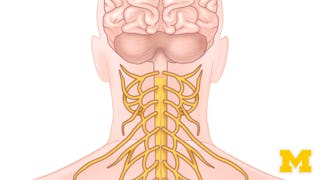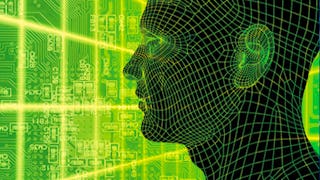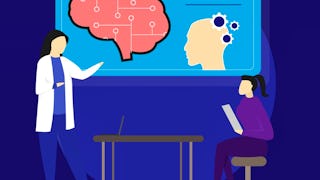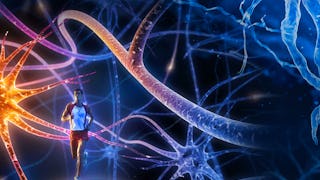Medical Neuroscience explores the functional organization and neurophysiology of the human central nervous system, while providing a neurobiological framework for understanding human behavior. In this course, you will discover the organization of the neural systems in the brain and spinal cord that mediate sensation, motivate bodily action, and integrate sensorimotor signals with memory, emotion and related faculties of cognition. The overall goal of this course is to provide the foundation for understanding the impairments of sensation, action and cognition that accompany injury, disease or dysfunction in the central nervous system. The course will build upon knowledge acquired through prior studies of cell and molecular biology, general physiology and human anatomy, as we focus primarily on the central nervous system.



(2,894 reviews)
Skills you'll gain
Details to know

Add to your LinkedIn profile
33 assignments
See how employees at top companies are mastering in-demand skills


Earn a career certificate
Add this credential to your LinkedIn profile, resume, or CV
Share it on social media and in your performance review

There are 18 modules in this course
Let's get started in Medical Neuroscience! Each module in Medical Neuroscience will begin with a brief description like this that provides you with an overview of the module. In this first module, you will get to know something about Prof. White and his career in neuroscience; you will understand the scope of Medical Neuroscience, its learning resources, your responsibilities for maximizing your benefit in this course, and you will learn Prof. White's tips on how best to study and learn. At the end of this module, please take the ungraded preliminary quiz, "Are you ready for Medical Neuroscience", to self-assess your background knowledge. Your score on this quiz will not count toward your overall score in this course. However, you should be able to pass this quiz (score 70% or better) if you are ready for the academic challenge of this course. Students who are likely to achieve their goals in Medical Neuroscience should be able to successfully answer nearly all of the quiz questions on their first attempt and feel comfortable with assessment questions at this level of knowledge.
What's included
5 videos2 readings1 assignment
Your introduction to Medical Neuroscience continues as you experience in this module a brief introduction to the human brain, its component cells, and some basic anatomical conventions for finding your way around the human central nervous system.
What's included
4 videos1 reading1 assignment
We now begin in earnest our lessons on neuroanatomy with the surface of the human brain, including a brief run through the cranial nerves and the blood supply to the CNS. In this module, you will learn the basic subdivisions of the vertebrate nervous system; however, your focus should be on the cerebral cortex. Along the way, you will be challenged to "build a digital brain" that should help you generate and improve your mental “model” of the cerebral hemispheres of the human brain. Another great way to refine your mental model is through sketching and crafting, so please do the learning objectives that are designed to help you make visible (and tangible) your understanding of the cerebral hemispheres.
What's included
12 videos2 readings2 assignments3 discussion prompts
What's included
12 videos2 readings2 assignments1 discussion prompt
We now turn our attention from the tangible (human neuroanatomy) to the physiological as we explore the means by which neurons generate, propagate and communicate electrical signals. After exploring those structures in the human brain that are visible to the unaided eye, we must now sharpen our focus and zoom-in, as it were, to the unitary level of organization and function in the central nervous system: to the level of individual neurons and their component parts that are crucial for neural signaling.
What's included
9 videos1 reading1 assignment3 discussion prompts
Let’s continue our studies of neural signaling by learning about what happens at synaptic junctions, where the terminal ending of one neuron meets a complementary process of another excitable cell.
What's included
13 videos2 readings2 assignments1 discussion prompt
We have reached a significant juncture in Medical Neuroscience as we turn our attention to the organization and function of the sensory systems. We will begin our studies with the somatic sensory systems, which includes subsystems for mechanical sensation and pain/temperature sensation. But before we get there, it is worth considering first some organizing principles that will set the stage for studies of somatic sensation and all the other sensory systems of the body.
What's included
16 videos2 readings2 assignments2 discussion prompts
This module will provide lessons that are designed to help you understand the basic mechanisms by which light is transduced into electrical signals that are then used to construct visual perceptions in the brain. Your studies of the visual system will benefit you at this point in the course, but also in later studies when we use the visual system as a model for understanding general principles of developmental plasticity. Lastly, it is worth noting how much of the forebrain contains elements of the visual pathways. Thus, injuries and disease in widespread regions of the brain may have a clinically important impact on visual function. All the more reason to learn these lessons well as you progress in Medical Neuroscience.
What's included
12 videos2 readings2 assignments
Our survey of the sensory systems continues as we now turn our attention to the auditory system, the vestibular system, and the chemical sensory systems. As you study this content, notice the similarities and the differences that pertain to the general mechanisms of sensory transduction and the broad organization of the central pathways in each of these sensory systems. In particular, note the similarity in transduction mechanisms for audition and vestibular sensation; and note the “logic” of sensory coding in the chemical sensory systems.
What's included
22 videos3 readings3 assignments1 discussion prompt
We come now to another pivot in Medical Neuroscience where our focus shifts from sensation to action. Or to borrow a phrase made famous by C.S. Sherrington more than a century ago (the title of his classic text), we will now consider the “integrative action of the nervous system”. We will do so in this module by learning the basic mechanisms by which neural circuits in the brain and spinal cord motivate bodily movement.
What's included
18 videos2 readings2 assignments4 discussion prompts
At this juncture in our exploration of motor control, let’s focus on one of the best studied paradigms for understanding the neural control of movement: the eye movement system.
What's included
6 videos1 reading1 assignment
Next, we will consider two major brain systems that modulate the output of upper motor neuronal circuits: the basal ganglia and the cerebellum. Take note: the output of these systems is NOT directed at lower motor circuits directly; rather, their output engages the motor thalamus and brainstem upper motor neuronal circuits. Thus, the actions of the basal ganglia and cerebellum are to modulate, rather than command, the activities of upper motor neurons. As you study the lessons in this module, appreciate how the basal ganglia and cerebellum function in a somewhat complementary fashion to modulate the initiation and coordination of movement, respectively.
What's included
11 videos2 readings2 assignments2 discussion prompts
We conclude our survey of movement and motor control by considering the visceral motor system, perhaps better known as the autonomic nervous system. As you study this lesson, consider how the disparate physiology of the viscera has impact not only on the internal state of the body, but also on implicit processing in the forebrain. We will return to this matter when we consider the neurobiology of emotions near the conclusion of Medical Neuroscience
What's included
8 videos1 reading1 assignment1 discussion prompt
This module represents another turning point in Medical Neuroscience. Now that we have surveyed human neuroanatomy and our sensory and motor systems, we are ready to take a step back and consider how this magnificent central nervous system came to be the way that it is. We will also learn how the brain re-wires itself across the lifespan as genetic specification, experience-dependent plasticity and self-organization continue to interact, re-shaping the structure and function of neural circuits throughout the central nervous system.
What's included
23 videos3 readings3 assignments1 discussion prompt
It may surprise you to know that in all of our studies of the neural systems for sensation and action, we have yet to properly account for the organization and function of roughly 75% of the entire cerebral mantle. Thus, only 25% of the cerebral cortex is accounted for by the modal sensory and motor cortical areas. The majority of the human cerebral cortex is multi-modal cortex that associates signals derived from one or more modal systems. We now turn our attention to this “associational cortex” as we consider more complex aspects of brain function.
What's included
11 videos1 reading1 assignment2 discussion prompts
In this concluding module of Medical Neuroscience, we will consider the neurobiology of sleep and the neurobiology of emotion, including addiction. Both topics involve explorations of complex, widely distributed systems in the forebrain and brainstem that modulate states of body and brain.
What's included
13 videos2 readings2 assignments1 discussion prompt
This module contains materials that will help you prepare for the final challenge in Medical Neuroscience: our clinical case-based, Comprehensive Final Exam.
What's included
1 video1 reading5 assignments
Please allow me a few more moments of your time to express my thanks for all your efforts to make it through Medical Neuroscience, and to wish you well on all your future endeavors!
What's included
1 video
Instructor

Offered by
Recommended if you're interested in Research


University of Michigan


University of Washington


Johns Hopkins University


Peking University
Why people choose Coursera for their career




Learner reviews
2,894 reviews
- 5 stars
92.88%
- 4 stars
5.28%
- 3 stars
0.55%
- 2 stars
0.27%
- 1 star
1%
Showing 3 of 2894
Reviewed on Nov 16, 2017
I found this course extremely useful. It was exactly what I needed and expected. A structured study of the brain and the spinal chord starting at the cellular level. A perfect course!
Reviewed on Mar 26, 2019
I used this as preparation material for a module/test for my graduate degree and i found the videos to be clearer, more complete, and helpful than my actual courses. That is quite impressive.
Reviewed on Nov 11, 2023
Absolutely loved every minute of this course! Thank you so much for all the hard work and effort it took to make this course, it was a challenging yet very enjoyable experience of learning.
New to Research? Start here.

Open new doors with Coursera Plus
Unlimited access to 10,000+ world-class courses, hands-on projects, and job-ready certificate programs - all included in your subscription
Advance your career with an online degree
Earn a degree from world-class universities - 100% online
Join over 3,400 global companies that choose Coursera for Business
Upskill your employees to excel in the digital economy
Frequently asked questions
No. Completion of a Coursera course does not earn you academic credit from Duke; therefore, Duke is not able to provide you with a university transcript. However, your electronic Certificate will be added to your Accomplishments page - from there, you can print your Certificate or add it to your LinkedIn profile.
Access to lectures and assignments depends on your type of enrollment. If you take a course in audit mode, you will be able to see most course materials for free. To access graded assignments and to earn a Certificate, you will need to purchase the Certificate experience, during or after your audit. If you don't see the audit option:
The course may not offer an audit option. You can try a Free Trial instead, or apply for Financial Aid.
The course may offer 'Full Course, No Certificate' instead. This option lets you see all course materials, submit required assessments, and get a final grade. This also means that you will not be able to purchase a Certificate experience.
When you purchase a Certificate you get access to all course materials, including graded assignments. Upon completing the course, your electronic Certificate will be added to your Accomplishments page - from there, you can print your Certificate or add it to your LinkedIn profile. If you only want to read and view the course content, you can audit the course for free.
More questions
Financial aid available,


